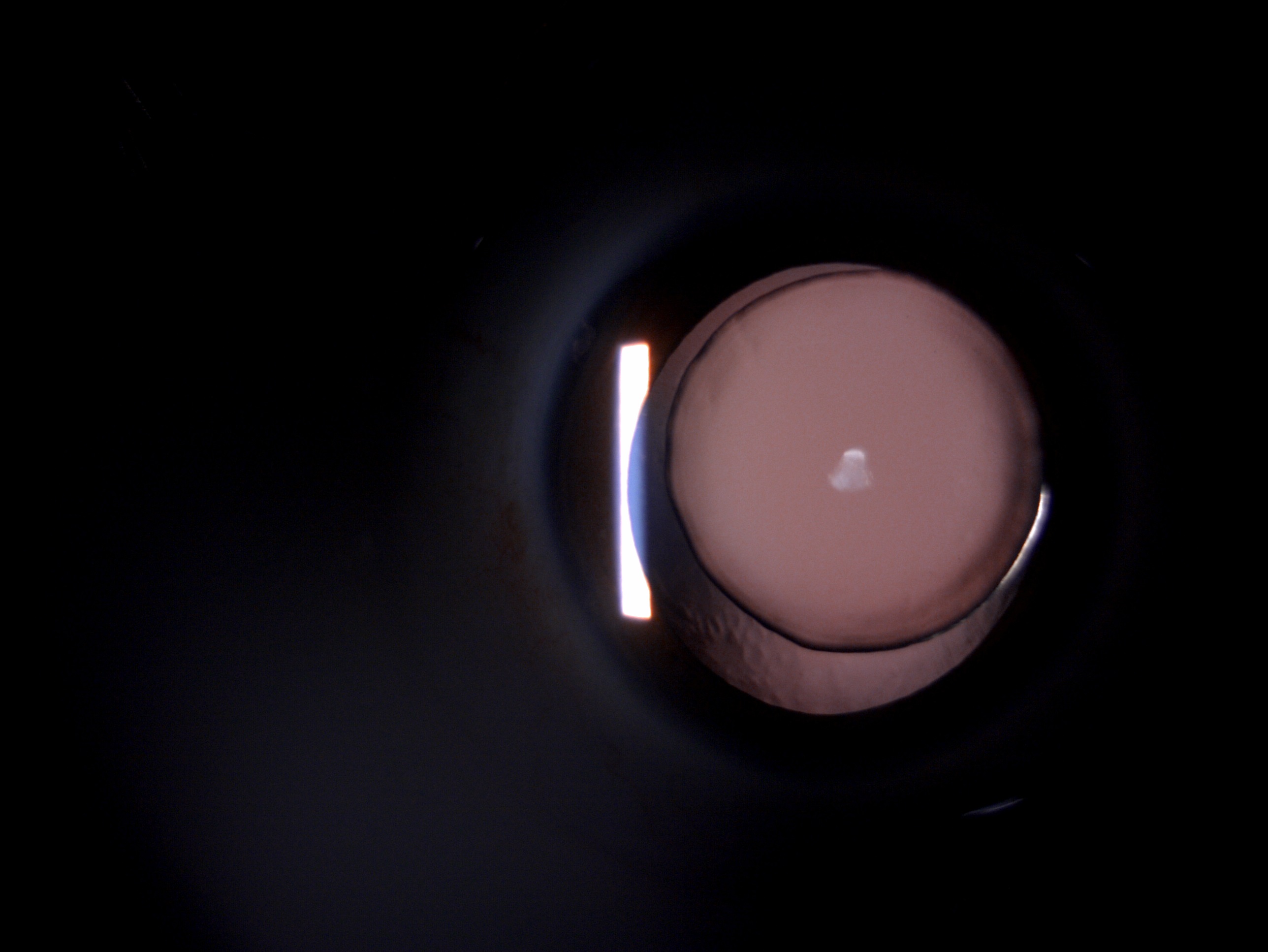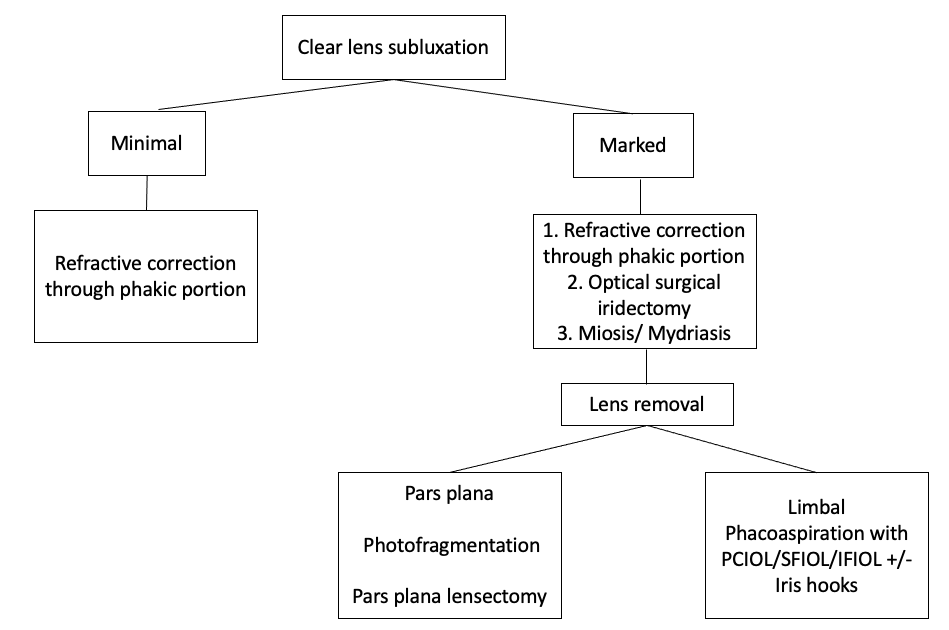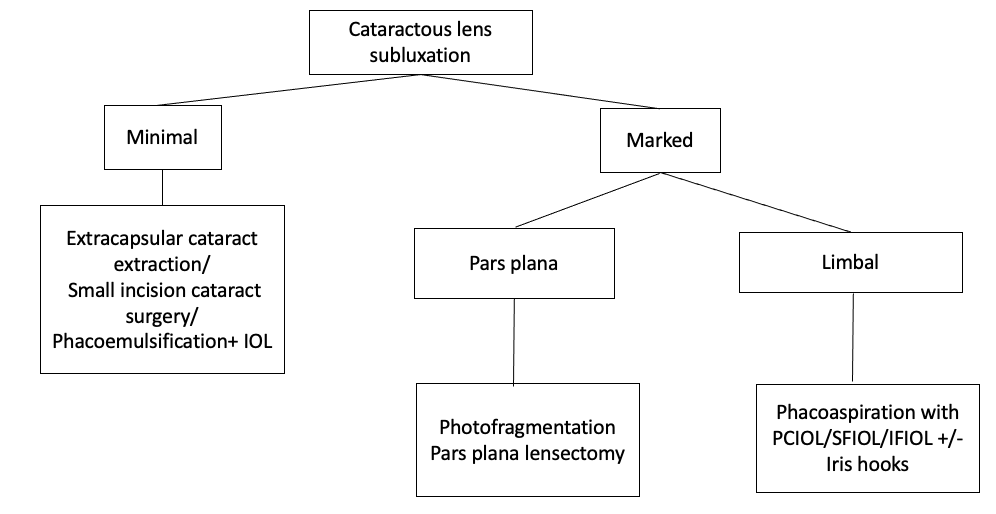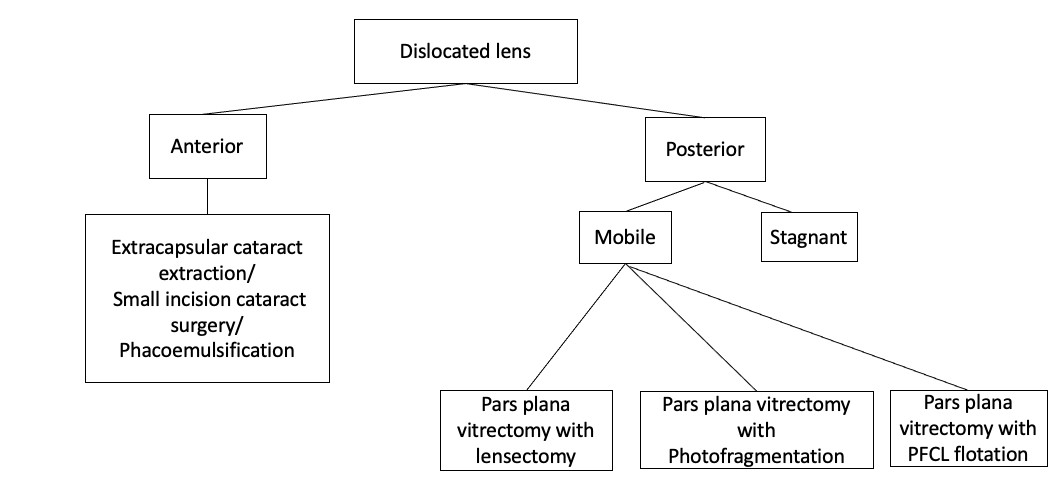[2]
Chandra A,Charteris D, Molecular pathogenesis and management strategies of ectopia lentis. Eye (London, England). 2014 Feb;
[PubMed PMID: 24406422]
[3]
Hsu HY,Edelstein SL,Lind JT, Surgical management of non-traumatic pediatric ectopia lentis: A case series and review of the literature. Saudi journal of ophthalmology : official journal of the Saudi Ophthalmological Society. 2012 Jul;
[PubMed PMID: 23961012]
Level 2 (mid-level) evidence
[4]
Goldberg MF, Clinical manifestations of ectopia lentis et pupillae in 16 patients. Ophthalmology. 1988 Aug;
[PubMed PMID: 3266004]
[5]
Jin GM,Fan M,Cao QZ,Lin JX,Zhang YC,Lin JQ,Wang YY,Young CA,Zheng DY, Trends and characteristics of congenital ectopia lentis in China. International journal of ophthalmology. 2018;
[PubMed PMID: 30225232]
[6]
Masoud MT,Huda SN,Saboor T, Ectopia lentis caused by blunt eye trauma. British journal of hospital medicine (London, England : 2005). 2007 Mar;
[PubMed PMID: 17419473]
[7]
Chandra A,Aragon-Martin JA,Hughes K,Gati S,Reddy MA,Deshpande C,Cormack G,Child AH,Charteris DG,Arno G, A genotype-phenotype comparison of ADAMTSL4 and FBN1 in isolated ectopia lentis. Investigative ophthalmology
[PubMed PMID: 22736615]
[8]
Nelson LB,Maumenee IH, Ectopia lentis. Survey of ophthalmology. 1982 Nov-Dec;
[PubMed PMID: 6984233]
Level 3 (low-level) evidence
[9]
Safi M,Nejad SK,O'Hara M,Shankar SP, Ectopia Lentis et Pupillae Caused by ADAMTSL4 Pathogenic Variants and an Algorithm for Work-up. Journal of pediatric ophthalmology and strabismus. 2019 Jul 5;
[PubMed PMID: 31282960]
[11]
Rodrigo BJ,Paulina LL,Francesc Mde R,Eduardo TT,Alejandro N, Intraocular lens subluxation in marfan syndrome. The open ophthalmology journal. 2014;
[PubMed PMID: 25279020]
[12]
Brown OR,DeMots H,Kloster FE,Roberts A,Menashe VD,Beals RK, Aortic root dilatation and mitral valve prolapse in Marfan's syndrome: an ECHOCARDIOgraphic study. Circulation. 1975 Oct;
[PubMed PMID: 1157278]
[14]
Yang GY,Huang X,Chen BJ,Xu ZP, Weill-Marchesani-like syndrome caused by an FBN1 mutation with low-penetrance. Chinese medical journal. 2021 Mar 23;
[PubMed PMID: 34075901]
[15]
Neely DE,Plager DA, Management of ectopia lentis in children. Ophthalmology clinics of North America. 2001 Sep;
[PubMed PMID: 11705149]
[16]
Wasim M,Khan HN,Ayesha H,Iqbal M,Tawab A,Irfan M,Kanhai W,Goorden SMI,Stroomer L,Salomons G,Vaz FM,Karnebeek CDMV,Awan FR, Identification of three novel pathogenic mutations in cystathionine beta-synthase gene of Pakistani intellectually disabled patients. Journal of pediatric endocrinology
[PubMed PMID: 34905667]
[17]
Sakai LY,Keene DR,Renard M,De Backer J, FBN1: The disease-causing gene for Marfan syndrome and other genetic disorders. Gene. 2016 Oct 10;
[PubMed PMID: 27437668]
[18]
Jones W,Rodriguez J,Bassnett S, Targeted deletion of fibrillin-1 in the mouse eye results in ectopia lentis and other ocular phenotypes associated with Marfan syndrome. Disease models
[PubMed PMID: 30642872]
[19]
Ahram D,Sato TS,Kohilan A,Tayeh M,Chen S,Leal S,Al-Salem M,El-Shanti H, A homozygous mutation in ADAMTSL4 causes autosomal-recessive isolated ectopia lentis. American journal of human genetics. 2009 Feb;
[PubMed PMID: 19200529]
[20]
Chen T,Chen J,Jin G,Zhang M,Chen Z,Zheng D,Jiang Y, Clinical Ocular Diagnostic Model of Marfan Syndrome in Patients With Congenital Ectopia Lentis by Pentacam AXL System. Translational vision science
[PubMed PMID: 34061947]
[21]
Wilczyński TK,Niewiem A,Leszczyński R,Michalska-Małecka K, Recurrent Intraocular Lens Dislocation in a Patient with Familial Ectopia Lentis. International journal of environmental research and public health. 2021 Apr 25;
[PubMed PMID: 33922930]
[22]
Rezar-Dreindl S,Stifter E,Neumayer T,Papp A,Gschliesser A,Schmidt-Erfurth U, Visual outcome and surgical results in children with Marfan syndrome. Clinical
[PubMed PMID: 31325202]
[23]
Lian Z,Cao Q,Qi H,Young CA,Zhang X,Jin G,Zheng D, Accuracy of intraocular lens power calculation formulas for eyes with scleral-sutured intraocular lens in congenital ectopia lentis. Journal of cataract and refractive surgery. 2021 Dec 7;
[PubMed PMID: 34978783]
Level 2 (mid-level) evidence
[24]
Gehle P,Goergen B,Pilger D,Ruokonen P,Robinson PN,Salchow DJ, Biometric and structural ocular manifestations of Marfan syndrome. PloS one. 2017;
[PubMed PMID: 28931008]
[25]
Nistri S,De Cario R,Sticchi E,Spaziani G,Della Monica M,Giglio S,Favilli S,Giusti B,Stefano P,Pepe G, Differential Diagnosis between Marfan Syndrome and Loeys-Dietz Syndrome Type 4: A Novel Chromosomal Deletion Covering TGFB2. Genes. 2021 Sep 22;
[PubMed PMID: 34680857]
[26]
De Backer J, Cardiovascular characteristics in Marfan syndrome and their relation to the genotype. Verhandelingen - Koninklijke Academie voor Geneeskunde van Belgie. 2009;
[PubMed PMID: 20232788]
[27]
Mansour AM,Younis MH,Dakroub RH, Anterior segment imaging and treatment of a case with syndrome of ectopia lentis, spontaneous filtering blebs, and craniofacial dysmorphism. Case reports in ophthalmology. 2013 Jan;
[PubMed PMID: 23687502]
Level 3 (low-level) evidence
[28]
Jin C,Wang Q,Li J,Zhu Y,Shentu X,Yao K, A recurrent PAX6 mutation is associated with aniridia and congenital progressive cataract in a Chinese family. Molecular vision. 2012;
[PubMed PMID: 22393272]
[29]
Avalos-Lara SJ,Antonio-Aguirre B,Perez-Ortiz AC,Mendoza Velásquez C,Camacho-Ordoñez A,Palacio Pastrana C, Spherophakia and Ectopia Lentis in a Sturge-Weber Patient: A Case Report. Case reports in ophthalmology. 2020 May-Aug;
[PubMed PMID: 32884550]
Level 3 (low-level) evidence
[30]
Lalramhluni R,Rath S,Shrivastav A,Singh PK,Mayor R,Singh S, Refractive and Visual Outcomes after Scleral Fixated Intraocular Lens Implantation in Children with Ectopia Lentis. Nepalese journal of ophthalmology : a biannual peer-reviewed academic journal of the Nepal Ophthalmic Society : NEPJOPH. 2020 Jan;
[PubMed PMID: 32799242]
[31]
Şimşek T,Beyazyıldız E,Şimşek E,Öztürk F, Isolated Microspherophakia Presenting with Angle-Closure Glaucoma. Turkish journal of ophthalmology. 2016 Oct;
[PubMed PMID: 28058167]
[32]
Erdogan G,Kandemir Besek N,Onal Gunay B,Agca A, Outcomes of three surgical approaches for managing ectopia lentis in Marfan syndrome. European journal of ophthalmology. 2021 Feb 7;
[PubMed PMID: 33550842]
[33]
Kazemi S,Wirostko WJ,Sinha S,Mieler WF,Koenig SB,Sheth BP, Combined pars plana lensectomy-vitrectomy with open-loop flexible anterior chamber intraocular lens (AC IOL) implantation for subluxated lenses. Transactions of the American Ophthalmological Society. 2000;
[PubMed PMID: 11190027]
[34]
Gurnani B,Kaur K,Sekaran S, First case of coloboma, lens neovascularization, traumatic cataract, and retinal detachment in a young Asian female. Clinical case reports. 2021 Sep;
[PubMed PMID: 34484773]
Level 3 (low-level) evidence
[35]
Gurnani B,Kaur K,Gireesh P, A rare presentation of anterior dislocation of calcified capsular bag in a spontaneously absorbed cataractous eye. Oman journal of ophthalmology. 2021 May-Aug;
[PubMed PMID: 34345149]
[36]
Gurnani B,Kaur K, Rare traumatic anterior dislocation of capsular tension ring-intraocular lens complex in-toto. Indian journal of ophthalmology. 2020 Nov;
[PubMed PMID: 33120674]
[37]
Chen J,Tang Y,Jing Q,Lu Y,Jiang Y, Analysis of Corneal Spherical Aberrations in Chinese Bilateral Ectopia Lentis Patients. Frontiers in medicine. 2021;
[PubMed PMID: 34869429]
[38]
Puthalath AS,Gupta N,Samanta R,Verma PK, Congenital aniridia with ectopia lentis and unilateral buphthalmos: an unusual presentation. BMJ case reports. 2021 Aug 17;
[PubMed PMID: 34404663]
Level 3 (low-level) evidence
[39]
Muthukumar B,Chhablani PP,Salman A,Bhandari V,Kapoor R, Comparison of retropupillary fixated iris claw lens versus sclera fixated lens for correction of pediatric aphakia secondary to ectopia lentis. Oman journal of ophthalmology. 2021 Jan-Apr;
[PubMed PMID: 34084030]
[40]
Esfandiari H,Ansari S,Mohammad-Rabei H,Mets MB, Management Strategies of Ocular Abnormalities in Patients with Marfan Syndrome: Current Perspective. Journal of ophthalmic
[PubMed PMID: 30820290]
Level 3 (low-level) evidence
[41]
Hoffman RS,Snyder ME,Devgan U,Allen QB,Yeoh R,Braga-Mele R,ASCRS Cataract Clinical Committee.,Challenging/Complicated Cataract Surgery Subcommittee., Management of the subluxated crystalline lens. Journal of cataract and refractive surgery. 2013 Dec;
[PubMed PMID: 24286841]
[42]
Wu-Chen WY,Letson RD,Summers CG, Functional and structural outcomes following lensectomy for ectopia lentis. Journal of AAPOS : the official publication of the American Association for Pediatric Ophthalmology and Strabismus. 2005 Aug;
[PubMed PMID: 16102486]
[43]
Duan Y,Li P,Ding T,Wang Y,Liao Y,Du Z,Ling J,Liu S,Li W,Liu Z, Combining clinical examination with exome sequencing for the diagnosis and treatment of Marfan syndrome: a case series of 6 families from China. Annals of palliative medicine. 2021 Sep;
[PubMed PMID: 34628919]
Level 2 (mid-level) evidence




